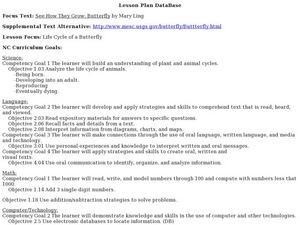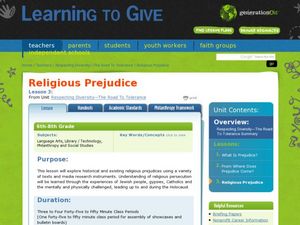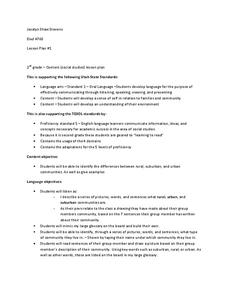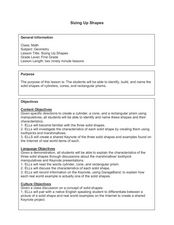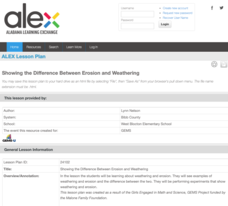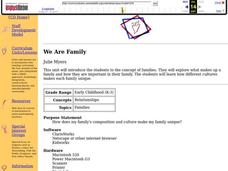Curated OER
What are the Kinds of Triangles?
Fifth graders classify triangles. In this triangle lesson, 5th graders learn about the characteristics that make up a triangle. They are instructed through video, PowerPoint slides, and teacher-led demonstrations.
Curated OER
See how They Grow: Butterfly
Students view butterflies and participate in a butterfly activity to learn needed vocabulary. In this butterfly life cycle activity, students access prior knowledge of butterflies. Students listen to a butterfly life cycle book....
Curated OER
You've Got Mail
First graders study the postal system and letter writing. They exchange class letters with another class in a different area and become pen pals with residents in a local nursing home.
Curated OER
Working Together to Improve Our Community
Students from the fourth grade research a solution to a community problem and converse with eighth graders via email. Eighth graders study the political process and work with the fourth graders to present information to the public to...
Curated OER
Respecting Diversity- The Road to Tolerance
Students use a graphic organizer to find similarities and differences in three religions. In this prejudice lesson plan, students understand the events leading up to the holocaust. Students understand that people who respected diversity...
Curated OER
History in the Making: The Tortilla
Fourth graders examine the history of the tortilla and extend the study across the curriculum. In this history of the tortilla lesson, 4th graders research the background of the tortilla, determine the ingredients, and work with the...
Curated OER
Geometry- Hands and Feet
Students identify units of measurement. In this measurement instructional activity, students predict the length and width of their hands and feet. Students discuss their findings and if their predictions were correct.
Curated OER
Measurement and Data Collecting using Image Processing
Young scholars trace the route of the historical event and measure the distance over which the people involved journeyed. A data sheet be constructed outlining the location of events, and the speed with which the journey occurred.
Curated OER
There's No Accountin with Ledgers
Tenth graders create and maintain a ledger, write an essay for the process, and learn to keep financial accounts through the ledger. In this ledger instructional activity, 10th graders define an accounting ledger and create one for the...
Curated OER
What is a Community?
Second graders write sentences in a graphic organizer about communities and what they include. In this community lesson, 2nd graders will also draw a picture based on their description.
Curated OER
Test Your Speaking And Listening Skills: A Fair Price?
In this consumer awareness activity, students look at a shopping list and write what is a fair price for each item and how much is the maximum they would be willing to pay. Students discuss their lists and may visit stores to see if...
Alabama Learning Exchange
The Causes of Pollution
Learners identify types of pollution. In this environmental lesson, students view a video and discuss the types of pollution. Learners create a poster to suggest ways to prevent pollution.
Alabama Learning Exchange
As Large As Life. . . A Poster of a Human Body System
Learners explore the major systems and functions of the human body. In this anatomy lesson, students make life-size outlines of bodies, diagram body systems, and present their work to their classmates.
Curated OER
Sizing Up Shapes
First graders explore geometric shapes. For this math lesson, 1st graders sort shapes into groups and discuss the characteristics of the shapes. Students build geometric shapes using toothpicks and marshmallows.
Curated OER
ESL General Knowledge Quiz 1- Fill in the Table
In this ESL general knowledge quiz worksheet, students answer 20 questions. They answer questions about bird, capital cities, money, countries, oceans, math, and geography. They are able to score 20 points by getting each answer correct.
Alabama Learning Exchange
Showing the Difference between Erosion and Weathering
Learners explore the concepts of weathering and erosion. After viewing pictures of both erosion and weathering, young scholars work in pairs to conduct an experiment with sugar cubes, water, sand, and a straw. They write their...
Alabama Learning Exchange
The Ocean Floor
Learners explore the ocean in this earth science lesson. They use the Internet to gather information on parts of the ocean including the beach, ocean floor, continental shelf, trenches, and the animals that inhabit these parts.
Baylor College
About Air
Give your class a colorful and tasty representation of the components of the mixture that we call air. Pop a few batches of popcorn in four different colors, one to represent each gas: nitrogen, oxygen, argon, and carbon dioxide. The...
Curated OER
Storytelling: Using the Arts to Enrich the Curriculum...
Students explore the art of storytelling and stories from various cultures. Students experience Japanese and Chinese culture as well as Greek mythology. Students create and present their own Greek mythology topic to the class.
Curated OER
Where Do I Live?
Students study the characteristics of communities. Students identify similarities and differences in communities. Students identify that all people have basic needs, understanding that these needs are met through the community. Students...
Curated OER
Writing a Formal Thank You Letter
Students research various formats for writing thank you letters in resource books and through a provided Internet site. They use these resources to write a thank you letter to a recent outside speaker who visited their class.
Curated OER
We Are Family
Learners explore art and stories that depict families in different cultures. They examine how family members help each other, create traditions, have fun and change or grow. They describe their own families and create a class family...
Curated OER
Understanding language registers as a means to more effective communication
Students become familiar with registers of language through class discussion and exposure to examples of a common fairy tale written in two different registers. Working in small groups, students then translate a story into two different...

